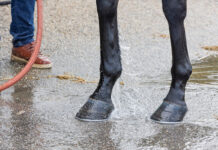
Tendon and ligament injury causes both economic and personal hardship for horse owners and industry professionals. A prolonged period of lay-up and rehabilitation is necessary, but whether the horse will be sound at the end of the rehabilitation period is uncertain. Lameness due to tendon and ligament injury is common in performance horses, affecting up to 25% of racehorses over a career and accounting for up to 43% of injuries in event horses, but it is also common to companion horses. Chronic lameness often follows the initial injury, with recurrence as high as 80% of racehorses with tendinitis.
The connective tissues from which tendons and ligaments are made are closely related. The highly organized structure of tendon enables it to be both strong and elastic. The cells within tendon produce the extracellular matrix that is organized into the fibers responsible for tendon’s unique mechanical properties. The tendon fibers are made of the protein collagen. The collagen forms long interlaced fibers in the same alignment with the tendon length, but the fibers also have a pleated pattern termed “crimp” that, like a spring, gives elasticity to the tendon.
When a tendon is injured, tendon fibers are ruptured or degraded by the inflammation. Attempts at healing frequently fall short of the exact structure of normal tendon. Abnormal orientation, size and organization of the collagen fibers that replace the original structure have less strength and elasticity. This is thought to increase the risk of re-injury once the healing process is over.
Because of the large amount of tissue matrix, tendons and ligaments have a relatively small number of blood vessels and cells that can make new normal tendon. When the tendon is damaged, the injured fibers and matrix need to be degraded and removed during the inflammatory process. It is thought that poor healing in tendons results from a prolonged and inefficient inflammation needed to remodel the tendon and prevent scarring. Therefore, tendon requires as long as nine to 12 month for complete healing. Even with a careful rehabilitation program, re-injury is common.
Both acute and chronic degenerative lesions in ligament occur in all equine endeavors, with suspensory ligament injury (desmitis) being the most common. Suspensory ligament desmitis can cause a chronic lameness and be resistant to currently available treatment modalities. Also, because current therapies have not been compared to each other or proven, it is often difficult to know which one gives the best chance for complete healing.
Our understanding of how some degenerative and acute injuries are related to each other is incomplete. The current thinking is that a low level of damage or degeneration occurs in the tendon or ligament over time. This damage is not completely repaired and can go unnoticed, because there may be no lameness, pain or swelling.
The failure to completely heal may be due to the inability of tendons to remodel or because of the repetitive forces these structures experienced regularly during exercise. Then, at a critical point during exercise or overexertion, the low-grade injury can no longer hold up to normal use or perhaps to an overload, creating an acute lesion with heat, swelling and lameness. This injury typically starts in the center or core of the tendon (called a core lesion), where blood and serum form a clot that replaces the tendon fibers and creates more inflammation that results in more damage over the following days or weeks.
While diagnosis of tendon and ligament injuries has improved dramatically in recent years and new treatment modalities are being used, a long lay-up period and the risk of recurrence are still factors for recovery. Newer treatments such as injection with stem cells or platelet-rich plasma are promising, but their benefit has not been fully characterized and they may not decrease the time required for healing and remodeling.
Further research into the detection, causes and best treatments for tendon and ligament injury are all needed. In a survey of American Association of Equine Practitioners members by the AAEP Foundation in 2009, musculoskeletal disease was ranked No. 1 as the equine body system that needs further research. Additionally, 75% of respondents believed more research is needed to specifically help treat tendon and ligament injury. Though there has been much attention given to arthritis research, relatively little research has been directed toward tendon and ligament injury.
The importance of tendon and ligament injury cannot be understated; it can be responsible for the development of joint disease and is frequently associated with navicular disease. Research on tendon and ligament injuries will to help prevent and treat this cause of lameness.
Read more about tendon and ligament injury causes and prevention >>
By Jennifer G. Barrett, DVM, Ph.D., DACVS
Marion duPont Scott Equine Medical Center,
Virginia-Maryland Regional College of Veterinary Medicine







good article
Very helpful, my horse has tendonitious in her front legs because a farrier trimed her feet too short at age two and now she is sixteen and is still never fully sound!
The more we know the better.
Good article.
This is a very informative article. I agree that tendon damage is common if not protected. To learn a little about how to protect the tendon check out our Web Site http://www.HorsesDIY.com.
wats good to put on a horse when he has
a bowed tendon